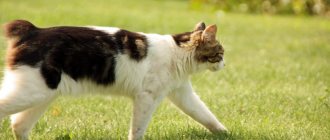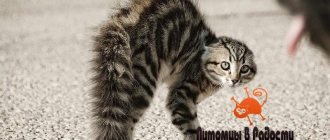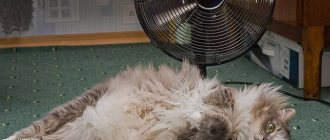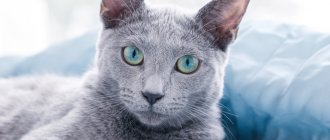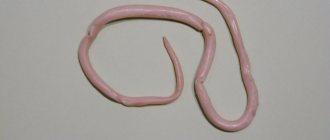Types of tail deformation
Tail deformation can be of several types; the most common are kinks, kinks and bends. When a bend occurs, the next vertebra of the tail rises above the previous one, resulting in the formation of a “step up the ladder.” Deformed vertebrae differ in size and have rounded edges.
The opposite defect is a fracture, in which the vertebrae are located “step down”.
The bend is clearly visible to the naked eye; it seems that several vertebrae have “jumped out” beyond the imaginary line that runs through the middle of the vertebrae from the base to the tip of the tail. The bodies of the protruding vertebrae often have a wedge-shaped shape.
Congenital tail defects
We are talking about a structural feature of the tail, which occurs quite often in newborn kittens. According to statistics, some cat breeds are especially susceptible to congenital tail defects (for example, Burmese or Scottish fold cats).
In itself, such a hall is not scary and does not in any way threaten the life or health of the pet. You just have to remember that if a cat has a broken tail, the path to exhibitions and competitions among its own kind will be closed. Such an individual is considered to be out of condition, that is, not suitable in terms of body structure parameters. So an animal with a congenital crease will delight the eye and heart exclusively at home. You will have to forget about the career of a “cat model”.
Another important factor is the ability of cats to pass on the peculiarity of their tail structure by inheritance. In other words, future kittens have every chance of repeating the fate of the “crooked-tailed” parent. Moreover, this anomaly may worsen, and the offspring may develop complications in the form of spinal disorders, coordination of movements and many other troubles. This is why an animal with a crooked tail is not suitable for breeding. The best way out of the situation would be castration or sterilization.
Why is the tail “broken”
Kittens with tail deformities can appear in litters of both outbred and purebred cats. Instead of a straight tail, the owners see tails bent to the side, broken in several places, or hooked. Regardless of the type of deformity, such a deviation permanently prohibits access to breeding and exhibitions. A fluffy kitten can become an excellent pet that retains all the characteristics of the breed, but the animal forever falls into the “home only” category.
Slight miscorrection of the tail, which is expressed in the last and penultimate vertebrae, is acceptable in some breeds, but breeding animals in such a situation is not recommended.
Veterinarians and breeders say that “unique” tails indicate the degeneration of the breed and are a serious genetic defect. When breeding such animals, you put all the offspring at risk, since the next generations may have not only a crooked tail, but also serious spinal disorders. Curvature of the spine is a direct path to congenital pathologies of internal organs, as a result of which the offspring will be non-viable.
The exact nature of such genetic abnormalities has not been established, but assumptions agree that closely related relationships are to blame.
Main predisposing factors
There are quite a few of them, but more often than others, various kinds of “tail” injuries lead to this phenomenon. For example, breeders living in rural areas and private homes often have crooked-tailed pets. What is this connected with? When a cat is let out for a walk, sometimes he does not have time to pull out his tail before the door closes... As a result, a fracture or serious injury to the tail. Since splints and plaster are rarely applied to this part of the body, the cat continues to walk, “flaunting” the damage. It heals poorly and takes a long time, which is why the animal has a “poorly” healed injury for the rest of its life. It is she who forms the crease of the tail.
Does this pose any danger to the cat's health or life? In principle, no. Your pet will not look very presentable, but there is no threat to it either . In theory. In the case when the tail has healed long ago, and only its strange bend reminds of the incident, there really is no reason for concern. It’s a different matter in situations where the organ has not yet healed, when there is an unhealed wound/ulcer directly at the site of injury, etc.
Tail like a passport
An exception to the “black list” are bob-tailed cat breeds; for them, deformation is the norm prescribed by the standard. In the animal world they are known as Mekong or Thai bobtails. In representatives of this breed, each tail is unique and has only its own inherent loops, kinks and bends. Not all of them are noticeable under the fur, but when palpated, the sign of the breed becomes obvious.
Each breed of animal is determined by specific features in appearance and character traits that are unique to it - this is called the breed standard, which must be recognized by various organizations of felinologists (TICA, FIFe, WCF, CFA, IFA, ICU, WACC, etc.) for each of them own rules of recognition. All purebred cats are given pedigrees.
First aid for tail injuries
First, you need to carefully trim the hair around the wound canal, cleaning its surface as much as possible. It is advisable to cover the wound with a sterile gauze pad so that the falling hair does not end up anywhere other than it. When you are done with hairdressing, just as carefully remove hairs, blood and adhering dirt from the edges of the wound (the same saline solution or warm boiled water). In any case, you need to work so that nothing foreign gets inside the wound canal - no fur, no water, no dirt. Washing damage (except for very light scratches) is strictly prohibited!
After this, some ointment can be applied to the edges of the wound (to facilitate subsequent removal of the bandage). It is best (and you probably have them in home medicine cabinets) to use tetracycline or ichthyol . Again, there is no need to push them “deeply”! Fatty creams and ointments prevent air access, and this is dangerous due to the possible development of anaerobic microflora. The surface of the wound, if possible, can be treated with streptocide powder . And only after this, having additionally covered the injury with a thin cotton-gauze napkin, apply a bandage.
By the way, the last one is the most difficult. It is necessary to bandage the wound so as not to impede the access of air and not to crush the large tail vessels. But at the same time, you need to try to do this so that the cat does not get rid of the bandage within a couple of minutes. What to do next?
Features of behavior and character
A distinctive feature is their attachment to the owner, and not to the house, like most cats. They are extremely neat and tidy. Thanks to their expressive eyes, it is extremely easy to establish rapport with them.
These cats, unlike others, do not hide their claws on their hind legs, so when they approach, a characteristic clicking sound is heard, like in dogs. In general, the behavior of Mekongs is similar to that of a dog: they run to the sound of a doorbell and often growl in response to it. Without fail, they sniff strangers and decide whether to let them into the house.
Animals of this breed are very sociable and talkative, while they do not meow, but make peculiar sounds that are characteristic only of them. Due to this feature, they are indispensable for people who lack communication.
They do not like disorder in the apartment and will put scattered things back into place, and then “express” their dissatisfaction to the owner.
Compared to cats, cats are more sociable and playful. At the same time, they will react very calmly to the presence of small children in the family and will allow them to squeeze and drag them, without showing any aggression towards the kids. They are very affectionate and attentive to people.
The intelligence of the animals is quite high, thanks to which they are easy to train and gladly carry out the commands of their owners.
Mekongs love to walk and hunt. Therefore, when living in a private house or at a dacha, they will get rid of rodents and will happily feast on insects; they especially love grasshoppers. Due to this feature, you should not keep fish, small rodents (for example, hamsters) or birds in parallel with them - they will certainly become the subject of hunting. At the same time, they get along well with dogs and even play together.
If the owner of the Mekong decides to have a second individual of the opposite sex, it is worth taking into account some behavioral features that differ from “classic” cat couples. Matriarchy reigns among these animals, cats take care of the females in every possible way, give them their “songs”, and try to win their attention. Once pregnant, the cat becomes extremely capricious, touchy and can play pranks. But as soon as the kittens are born, she turns into a caring mother.
At the same time, the second parent plays a special role in raising kittens. He must lick them, accustom them to the tray and order, and if the father does not cope well with his responsibilities, he will receive a “reprimand” from his wife. This behavior is due to the fact that the main food providers in the pride are cats.
How to feed your pet
The Mekong diet is not too different from the diet recommended for Siamese cats. When purchasing ready-made food, you can buy mixtures intended for Siamese. Kittens are accustomed to this diet gradually. First, kids eat fermented milk products (cottage cheese, kefir) and finely chopped meat. After half a year, they gradually switch to an adult diet.
When feeding natural food, you should not overfeed your pet with meat products or fish. This may cause the color to change. It is better to diversify your diet with dairy products, vegetables and fruits. This way the Mekong will receive a sufficient amount of vitamins and microelements.
History of development
The ancestors of the Mekong Bobtail are Siamese. Despite the fact that the first mentions of animals with the Siamese color, but with a short and curved tail, were found already in the 20th century. and even before, the breed was not recognized for a long time. Cats with a broken tail were considered a waste.
Only at the end of the last century did breeders from Russia begin to seek recognition of the short-tailed Siamese as a separate species. The first standard was developed and adopted in the mid-90s. And it was finally adjusted and approved in 2004 in Germany. The breed received an official name and was classified as the Siamese-Oriental type.
Care
This process will not require much time, since the Mekongs are extremely clean. It is worth paying attention to the coat, combing it with special brushes once a week, this is done to remove lost hairs.
During the molting period, you can increase the frequency of the procedure.
Cats are rarely bathed, 1-2 times a year is enough, they don’t like it. The animal's ears should be wiped with a cotton swab with a special product applied about once a month. Cats are clean and wash themselves a lot, and they do not have lacrimation, so there is no need to wash their eyes.
Host actions
What should an owner do if he discovers that his pet has a broken tail tip, base or middle part? The procedure depends largely on the duration of the injury :
- Old kink . Sometimes the fact of injury goes unnoticed by the owner and the tail gradually heals on its own. In this case, if nothing bothers the pet, no measures need to be taken.
- "Fresh" injury . The situation is completely different if the cat’s tail injury occurred just recently and was quite serious.
Putrefactive bacteria can enter the wound, after which suppuration and foul-smelling discharge will begin.
Therefore, if the cat has suffered a tail injury (of any severity), you should not start this process. The pet needs to be taken to the veterinarian urgently. Typically, a tail injury can be corrected with a tight bandage or cast. In extremely severe cases, the tail may be amputated above the fracture site.
Treatment of the disease
As a rule, the only effective treatment method is timely surgery. There is nothing strange about this: if the appearance of a “cauda equina” was provoked by injuries or pathologies leading to physical deformation of the structure of the spinal column, it is unlikely that good results will be achieved with the help of drug treatment. However, it is unreasonable to abandon it completely.
Thus, sedatives are prescribed in cases where a sick animal is experiencing severe pain. In mild cases, it is believed to help improve the pet's quality of life at no additional cost. However, anti-inflammatory corticosteroids are usually prescribed at the same time, since simply relieving pain does not help relieve the root cause of the pathology.
Please note that even in cases of regular treatment, the disease often recurs, after which the therapeutic course must be repeated. Methylprednisolone has proven itself well. It is administered lumbosacral-epidurally at a dose of 1 mg per kilogram of live weight. This drug (in combination with sedatives) is reported to achieve clinical cure in approximately 59% of cases.
We also note that for “horsetail”, physiotherapy often becomes an indispensable method of treatment. Even a regular massage (if performed correctly) can improve the quality of life of a sick cat. Acupuncture is also indicated (surprisingly, in such a situation it really helps).
Color
Until 2005, only 3 colors were officially recognized:
- Seal point or classic Siamese color. The coat has a creamy to light brown tint. Darker spots (even black-brown) on the face, paws, ears and tail.
- Red point is the rarest. The coat has a peach tint, and the characteristic spots have a reddish tint.
- Tortie point is a tortoiseshell color.
Torty Point
In subsequent years, the popularity of the breed increased and, thanks to selection, several more colors appeared:
- blue point – the fur on the body has a silvery tint, and the points on the face, tail and paws are bluish-pink;
- chocolate point – white body, and chocolate-colored spots;
- tabby – the dark letter “m” is clearly visible on the forehead, and the spots are striped.
Tabby color
Nurseries who are keen on breeding are now breeding cats with lilac and golden fur.
Content
This is an ideal breed for living in an apartment: they shed little, are easily left alone without suffering from it, do not have a specific cat smell and are very clean. Marks in the corners are left in extremely rare cases.
Kittens are more active and restless than adults. But these troubles will quickly end, because they grow up quickly. Puberty occurs at approximately 5-6 months, so it is important not to miss the maturation of the animal and to prevent unplanned matings, which is unsafe for a completely unformed organism.
In a pair of Mekong Bobtails, matriarchy prevails; the cat takes on the role of feeding the kittens and very carefully monitors the correct upbringing of the younger generation, which the cat is engaged in. Females are more independent in nature than males.
Classification of fractures
Veterinary specialists distinguish several types of fracture of the caudal vertebrae in a cat: closed, open and fracture.
Closed is characterized by the fact that the integrity of the tissues is preserved and no visible wounds are observed. This type of injury is most often diagnosed when an animal is stepped on, pinched by a door, or driven over by a car.
Open fractures are associated with a violation of the integrity of the skin, wounds and damage to surrounding tissues. From the wound, the owner can observe damaged caudal vertebrae. This type of damage is observed during collisions with vehicles, fights with cats and dogs, and falls from a height.
If the fracture occurs at a young age of the pet, when the skeletal system is not formed, a fracture of the caudal vertebrae occurs. In this case, no bone destruction is observed; the vertebrae simply bend under the influence of a traumatic factor.

